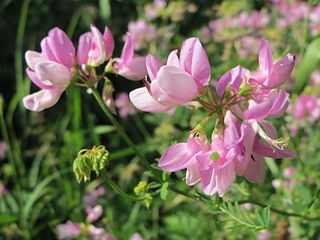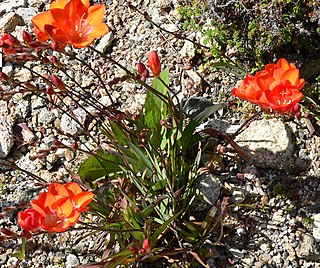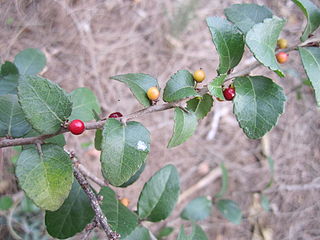
The Fabaceae or Leguminosae, commonly known as the legume, pea, or bean family, are a large and agriculturally important family of flowering plants. It includes trees, shrubs, and perennial or annual herbaceous plants, which are easily recognized by their fruit (legume) and their compound, stipulate leaves. The family is widely distributed, and is the third-largest land plant family in number of species, behind only the Orchidaceae and Asteraceae, with about 765 genera and nearly 20,000 known species.

The Faboideae are a subfamily of the flowering plant family Fabaceae or Leguminosae. An acceptable alternative name for the subfamily is Papilionoideae, or Papilionaceae when this group of plants is treated as a family.

Securigera varia, commonly known as crownvetch or purple crown vetch, is a low-growing legume vine. It is native to Africa, Asia and Europe and is commonly used throughout the United States and Canada for erosion control, roadside planting and soil rehabilitation. It has become an invasive species in many states of the US.
Iberica, a Latin word referring to the Iberian Peninsula, may refer to:

The tribe Loteae is a subdivision of the plant family Fabaceae, in the Robinioids. These genera are recognized by the USDA:

The genus Securigera contains a number of plant species commonly referred to as crownvetch. It is a segregate of the genus Coronilla. The name Securigera was first published by A. P. de Candolle in 1805 with the single species Securigera coronilla, which is now considered to be a synonym of Securigera securidaca(L.) Degen & Dörfl. (1897), based on the earlier publication of the same taxon as Coronilla securidacaL. in 1753.

Tritonia is a genus of flowering plants in the iris family first described as a genus in 1802. They are naturally distributed across southern Africa, with a high concentration of species in Cape Province of western South Africa. The genus is closely related to the genus Ixia.

Zygaena fausta is a member of the family Zygaenidae, the day-flying burnet moths. Its bright aposematic colours of red, white and black on the wings indicate to possible predators such as birds that it is foul tasting or poisonous. In flight, the bright red abdomen is revealed, contrasting with the white legs and black head and antennae; the thorax is black and white with an eye spot on each side. There appears to be a considerable variation in pattern among specimens from different parts of Europe.

Plebejus argyrognomon, common name Reverdin's blue is a butterfly of the family Lycaenidae. The species is named after Jacques-Louis Reverdin.

Polyommatus daphnis, the Meleager's blue, is a butterfly of the family Lycaenidae.

Cupido alcetas, the Provençal short-tailed blue, is a small butterfly that belongs to the family Lycaenidae.

Xylosma flexuosa, commonly known as brushholly or coronilla, is a species of flowering plant in the family Salicaceae, that is native to southern North America and northern South America. Its range stretches from southern Texas in the United States south through Mexico and Central America to Venezuela. It can also be found on the island of Curaçao in the Netherlands Antilles. Brush holly is a spiny evergreen shrub, usually reaching a height of 1–2 m (3.3–6.6 ft) but able to attain 6–8 m (20–26 ft) in height. Red and yellow berries around 7–8 mm (0.28–0.31 in) in diameter are found on the plant throughout the year. It is sometimes cultivated as an ornamental hedge.
S. orientalis may refer to:

Trifurcula cryptella is a moth of the family Nepticulidae. It is widespread throughout Europe, northwards to southern parts of Norway and Sweden, eastwards to Poland and the Balkan Peninsula, and south to the Mediterranean countries, but there it is rare and confined to mountainous regions. In Italy it has only been recorded from the northern part, in Portugal in the Serra da Estrêla, in Spain in the Cantabrian Mountains and possibly the Sierra Nevada. It is absent from the Mediterranean islands.
Trifurcula ortneri is a moth of the family Nepticulidae. It is widespread in the western Mediterranean region, where it is known from the Algarve in Portugal, Spain, France and Italy. It has also been recorded from Croatia (Dalmatia), Morocco and Algeria, eastern Austria, Hungary, Slovakia and Germany.

Coleophora colutella is a moth of the family Coleophoridae. It is found in all of Europe, except Great Britain and Ireland. It is an introduced species in North America.

Zygaena angelicae is a species of moth in the Zygaenidae family. It is found in Central Europe, from Greece to southern Germany and Thuringia. Z.angelicae has blue-black or green-black forewings, whose inner angles are strongly rounded off. On the forewings there are five or six red spots, two of which are always close together. In the five-spotted individuals, the spots on the underside of the wings are connected by a red stripe, in the six-spotted ones this is a large patch. The black margin of the red hind wings is wide. The antennal club is white at the tip less so than in Zygaena transalpina and the white may be completely absent. The wingspan is 30–33 mm.

Coronilla valentina, the shrubby scorpion-vetch, scorpion vetch or bastard senna, is a species of flowering plant in the genus Coronilla of the legume family Fabaceae, native to the Mediterranean Basin, and introduced into Kenya and the United States. It is an evergreen shrub growing to 80 cm (31 in) tall and wide, with pea-like foliage and fragrant, brilliant yellow flowers in spring and summer, followed by slender pods. Linnaeus observed that the flowers, remarkably fragrant in the daytime, are almost scentless at night.

Securigera elegans is a plant species in the genus Securigera.

Coronilla scorpioides, the yellow crownvetch, is a species of annual herb in the family Fabaceae. They have a self-supporting growth form and compound, broad leaves. Individuals can grow to 20 cm tall.
















